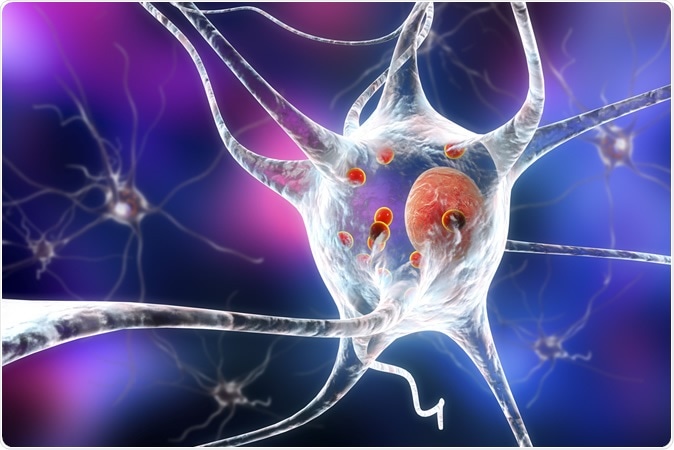The brain consists of about 100 billion neurons that form a complex and interconnected network in our brain, allowing us to generate complex thought patterns and actions. These neurons or nerve cells are the functional units of the nervous system that process and transmit information around the body. Neurodegenerative diseases develop with the progressive loss of these neurons.

Parkinson's disease. 3D illustration showing neurons containing Lewy bodies small red spheres which are deposits of proteins accumulated in brain cells that cause their progressive degeneration. Image Credit: Kateryna Kon / Shutterstock
Parkinson’s disease (PD) develops when specific nerve cells in the brain gradually break down or die. When these nerve cells die, they can no longer release a vital chemical messenger known as dopamine. With decreased dopamine levels, abnormal brain activity occurs, leading to symptoms such as shaking, difficulty walking, and stiffness.
The exact etiology of Parkinson’s disease remains unclear, but various studies have pointed to gene mutation and hereditary risk factors as possible drivers of the disease. Now, a team of scientists in the Christine Van Broeckhoven Laboratory (VIB-UAntwerpen Center for Molecular Neurology) has identified a novel risk gene for Parkinson’s disease. Their work is published in the journal Acta Neuropathologica.
The ATP1B gene
The gene, ATP1B, works by being a transporter for glucosylceramide, which is a lipid that plays a significant role in the development of Parkinson’s disease. A mutation in this gene leads to the loss of ATP10B protein and a reduced ATP10B gene expression, leading to the loss of neurons and sensitizes neurons to environmental risk factors of Parkinson’s disease. The scientists believe that focusing on this gene and possible mutations can lead to new therapies to treat patients with Parkinson’s disease.
Over the past decades, studies and researchers focused on determining the cause of Parkinson’s disease in the hopes of landing a treatment for the condition. Currently, there is no available treatment or cure for the neurodegenerative disease, but therapies are focused on reducing its symptoms and slowing its progression.
Identifying the genes and mutations that contribute to Parkinson’s disease added to the understanding of the disease process and mechanisms. In about 5 to 15 percent of patients with PD, genetic studies have noted various gene mutations that explained the segregation of disease in families with Parkinson’s disease between generations.
Through families, mutations in the bloodline are known to be highly penetrant, which means that carrier of the gene mutation is at a high risk of getting Parkinson’s disease in his or her lifetime. In some cases, such as sporadic patients who are non-familial Parkinson’s disease patients, little is known about the factors that caused the illness. These patients have various risk genes and mutations, coupled with environmental factors, which all contribute to the development of PD.
The study
To arrive at their findings, the team headed by Stefanie Smolders at the VIB-UAntwerpen laboratory identified mutations in the ATP10B gene in children with Parkinson’s disease at an early age, while their parents were healthy. The children were carriers of two mutations in the said gene, one on each chromosome inherited from the parents, similar to recessive inheritance.
Further, the team also identified another six carriers of two ATP10B gene mutations in a group of 617 unrelated patients. In the carriers, the team found that they have higher variability in the onset age at disease, indicating that the combination of many mutations may have various effects on the ATP10B expression.
Scientists from the KU Leuven team, headed by Shaun Martin, analyzed the function of the ATP10B gene. He revealed that the said gene acts as a transporter, removing lipids out of the lysosome, the part of the cell responsible for the digestion of macromolecules, old cell parts, and microorganisms. ATP10B transports glucosylceramide, which is a lipid that plays an essential role in Parkinson’s disease. Hence, the gene works by preserving the health and protects nerve cells against environmental factors tied to PD.
The discovery of the mutated gene can help in the development of therapies targeted for PD. The discovery also sheds light on the pathogenesis of the disease, providing a better understanding of fundamental changes that happen in nerve cells.
Parkinson’s disease affects more than 10 million people across the globe. In Europe alone, the neurodegenerative disease affects at least 2 million people while about 600,000 Americans are being diagnosed with PD each year. Patients with PD display or manifest motor and non-motor symptoms, hindering them from performing their daily activities. The common signs and symptoms of PD include tremors or shaking in the limbs, hands, and fingers, slowed movement, muscle stiffness, autonomic movement loss, writing changes, speech problems, and impaired balance or coordination, among others.
Currently, there is no treatment or effective therapy for the disease. The progression of the disease has a significant impact on the patient’s quality of life, prompting scientists worldwide to race to find a treatment for the disease.
Journal reference:
Martin S, Smolders S. et al. Mutated ATP10B increases Parkinson's disease risk by compromising lysosomal glucosylceramide expo. Acta Neuropathologica 2020, https://link.springer.com/article/10.1007%2Fs00401-020-02145-7